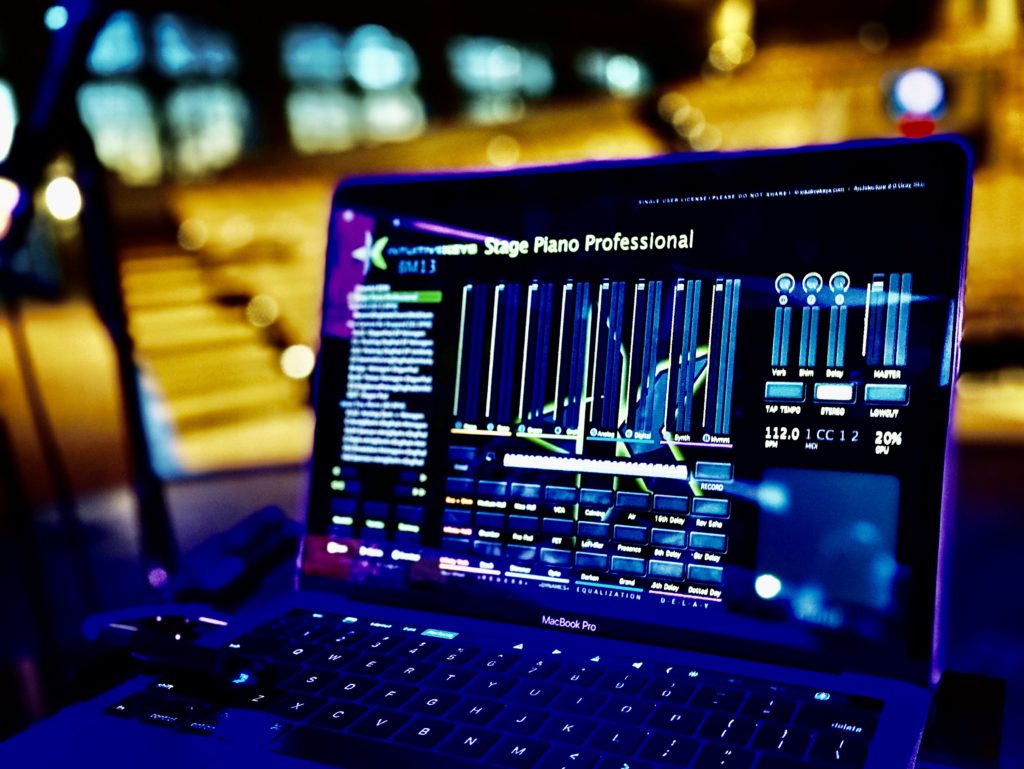Intuitive Keys is a MainStage template. That is, it’s a careful crafted architecture, coupled with a curated library of sounds, designed to instantly make MainStage your favorite keyboard for live performance.
Our Goal

We want to extract the maximum sonic potential from stock MainStage. We continue to focus on this because MainStage is always improving and because it seems to make choices geared toward the efficiency needed for live performance. This efficiency, which we define as sonic quality per computational power, continually reaps benefits. All our products are grounded in MainStage. Three products are 100% MainStage: 8INATOR, LIVE and the one that started it all, our LEGACY product. Our PRO version builds on LEGACY and judiciously adds favorite third party VSTs, including Valhalla DSP effects and Native Instruments Pianos (all are separate purchases).
Our Philosophy
1) We want to make you a better live keyboardist. We believe a musician changes the way an instrument sounds. We want to give you more control over that sound so that intuitively, the-sound-that-is-you, is what comes out.
2) We want you to respond intuitively in the moment. We believe a venue, a band, and a moment, changes the way an instrument should sound. We want to give you the control, and reduce the friction, so that you can pull or push something about your sound, based on what serves the song, and what is happening in the room, this time.
Our Thinking
We recognize both thinking slow, and thinking fast as different disciplines necessary for successfully performing with modern keyboards. We want to help you do both effectively.
| THINKING SLOW (the servant) | THINKING FAST (the gift) |
| This is the rigorous thinking that we do when we prepare for a set. | This is the kind of non-thinking we do when we’re in the moment experiencing a set. |
| This is logical thinking, the kind of thinking we typically do trying to solve a problem. | This is intuitive thinking, the kind of thinking we typically do engaged in sport. |
| When we’re doing our sound design and preparing for a particular set, we’re thinking slow. We’re logically solving problems. | When we’re playing live and responding in in the moment, we’re thinking fast. We’re intuitively responding in the moment. |
| We think slow when we are choose our patches, try out different layers, and figure out how we will cover all our parts. | We think fast when we voice our chords, set the mod-wheel, or push down on aftertouch. |
The intuitive mind is a sacred gift and the rational mind is a faithful servant. We have created a society that honors the servant and has forgotten the gift.
~ Albert Einstein
Our Templates Feature
- Interface: We provide a beautiful designed, highly functional graphical user interface (GUI) you will want to run in full-screen mode.
- Levels: Our patches are at a consistent level. Since pianos are implemented at the concert level, they provide an ideal basis for psycho-acoustically setting consistent patch volume levels.
- Gain-staging: You’ll notice our faders don’t move from patch to patch. They are designed to not overdrive with all faders up, so you never have to worry about improper gain-staging while playing live. You can pull levels down – groups or FX returns – but you can’t overdrive anything (at least unmodified).
- Octaves: All patches are in a consistent octave, relative to the pianos. Many patches have a MIDI transposer instantiated, so it’s easy to move a patch up or down an octave in your prep. Because we use aliases, making this change will impact every instance of this patch in the concert.
- Synthesis: We value synthesis over samples. Leveraging synths you already have, minimizes download size and expensive SSD space required on your hard drive.
- Triggering: In our Legacy and Pro versions, we employ arpeggiators, as was done with old-school synths. We do not implement complex triggers as a DJ might use. Our goal is to make you a better keyboardist, not a better DJ. If you find yourselves triggering sequences like a DJ would, we think it makes more sense to run tracks for those parts, and focus on the intentionality of playing live for more important parts.
- Efficiency: All our templates have an architecture that is highly efficient. Aliases are used as the basis for patch reuse in our combinations. Just one instantiation of each Piano exists at the concert level and can be activated at any time. We take advantage of FX sends and buses thus avoiding duplication of FX as well.
- Responsiveness: Every patch has carefully curated parameters tuned to the mod-wheel to add expression in a playable way. Nearly patch (where it makes sense) has carefully curated parameters carefully tuned to aftertouch to add expression in a playable way. Acoustic pianos have brightness or color mapped to mod-wheel over a playable range, (acoustic and electric pianos do not respond to aftertouch).
We think the best thing that can be said about our music is not “it sounded just like the album”, but rather “you had to be there”.
